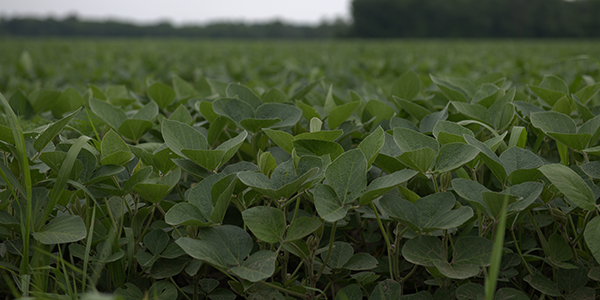AGRONOMICSUPPORT
YOU CAN TAKETO THE FIELD
Identify and Manage Sudden Death Syndrome in Your Soybeans
Let’s face it—farming isn’t easy.
Equipment breakdowns, supply chain disruptions, the weather (oh yes, the weather), and various crop diseases all plot against you and a successful growing season.
And for soybean farmers, one of those yield-robbing diseases conspiring against your ROI is sudden death syndrome.
SDS: What is it?
Soybean sudden death syndrome is caused by Fusarium virguliforme, a soil-borne fungus. This microorganism overwinters in the soil and crop residue and can survive for several years, waiting for the right moment to launch an attack.
Infection typically occurs shortly after your soybean seeds germinate, but symptoms don’t often show up until late in the season—from mid to late July through August.
At this time, toxins from the fungus start traveling up the xylem (that’s the water-conducting tissue in the stem), and physical issues begin.
SDS: What should I look for?

How do you know if your soybeans are suffering from SDS? That’s a tough one because some of the symptoms mimic other diseases.
Leaves will start yellowing and even look necrotic (dying, browning tissue), but the leaf veins will usually remain green.
Below ground, roots may show signs of decay, becoming brown or dark gray in color.
But don’t confuse these root symptoms with brown stem rot (another common soybean disease that looks almost exactly like SDS). Unlike with BSR, soybeans infected with SDS will maintain a white inner pith in the plant stem. So split that stem open and make sure!
SDS: What impact will it have on my yield?
Here’s the deal: yellowing, necrotic leaves lead to less photosynthesis. Less photosynthesis leads to less growth/development. And less growth/development leads to less yield.
But yield loss is HIGHLY variable and determined by many factors. Field history, when symptoms arise, and even the presence of soybean cyst nematode can all impact SDS damage. On top of that, SDS symptoms are often patchy throughout a field.
At any rate, yield loss equals loss of ROI, so management and prevention should be taken seriously.
SDS: What can I do to prevent and manage the disease?
Cool, wet field conditions shortly after planting (or even later in the season) are prime real estate for infection and symptom development. Compacted soils pose an even greater risk, and irrigated fields may also be susceptible.
So what can you do? Here are some ideas:
Crop rotation:
Breaking the disease cycle is an excellent prevention tool. However, a traditional corn/soybean rotation may not be enough, since the fungus can easily chill out in corn residue. Work with your LG Seeds agronomist to identify your disease pressure, and see if adding in a third crop is a good idea for your farm.
Tillage and delayed planting:
Airing out your soil and waiting for warmer weather will definitely quash those favorable, fungus-growing conditions, but waiting to plant can have an impact on yield, and tillage doesn’t exactly work well if you have a no-till system.
Resistant varieties and seed treatments:
One of the best things you can do to prevent SDS issues is to work with your LG Seeds agronomist and select disease-resistant varieties and protective seed treatments. Varieties like our LGS1203E3 and our LGS2851E3 have excellent SDS ratings. And when considering seed treatment options, AgriShield® MAX with Saltro® provides superior protection against SDS and reduces stress on the plant.
LG Seeds is By Your Side
Whether you’re dealing with SDS in your soybeans—or any other issues you’re bound to face as a producer—you’ve got a reliable partner in the field committed to your success. Contact your LG Seeds agronomist today if you need solutions built for how you grow.






Agronomy Team